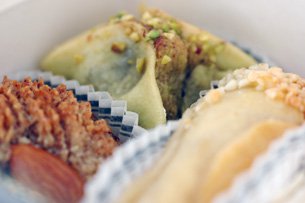
Barbie dolls didn’t do much for me when I was little, but I had a passion for plush animals. Each of them had a name and a set of personality traits (often refined by my father, who would improvise bedtime shows for my sister and me, with voices and everything), and they felt more alive than I think grownups can really remember. A direct consequence of this was that, even though I had preferences, naturally — I remember a black crow I’d won at the Jardin d’Acclimatation: it was ugly, it smelled funny, and I couldn’t bring myself to really love it –, I forbid myself to even admit these feelings, for fear of hurting theirs.
But now that I’m more or less an adult and have a pretty strong hunch that inanimate objects can’t get upset, I feel comfortable listing a few of my current edible and drinkable favorites from recent food shopping excursions. (If, however, the rest of my pantry turns sour all of a sudden, I may have to remove the post, I’m sure you’ll understand.)
~ Beurre au sel fumé (smoked salt butter) by Jean-Yves Bordier
Bordier can be described as the butter darling of the French gastronomic scene. His hand-beaten, hand-shaped butter is indeed outstanding, and his latest creation (yes, we now live in a world where the line between the artist and the artisan is blurrier by the day) is unlike anything I’ve tasted before: it is a butter that’s flavored with a mix of salt and spices — I understand this smoked salt follows a Norwegian technique — to give it smoky, almost earthy notes that reveal themselves in the back of your palate, in the aftermath of the rich yet refreshing butter kick.
It is splendid on fish and steamed (or mashed) potatoes, it can be spread on rye bread to eat with oysters, and I had such interesting results using it in a mini-batch of shortbread, that I must try it in salted butter caramels.
I buy my Bordier butter from Les Papilles Gourmandes, a neighborhood shop I’ve mentioned before (they also stock the unsalted, salted, and seaweed varieties), but it can also be found elsewhere in the city (La Grande Epicerie, Da Rose, Fauchon, Pascal Trotté’s cheese shop…) and, of course, right at the source in Saint-Malo.
Jean-Yves Bordier Map it!
9, rue de l’Orme – 35400 Saint-Malo
02 99 40 88 79
Les Papilles Gourmandes Map it!
26 rue des Martyrs – 75009 Paris
01 45 26 42 89
~ Sables blancs, a lightly flavored white tea from Le Parti du Thé
I like Mariage Frères as much as the next girl (though probably not as much as this next girl) but these days I am much more excited about the teas at Le Parti du Thé. This independant tea seller was recommended to me by Valérie Gentil of Beau et Bon (a quirky food shop I just as heartily recommend), and the first time I visited I had to physically restrain myself from buying a bit of each of their varieties — since they have over three hundreds, you can imagine why restraint is important.
The three kinds I’ve liked best so far are the Sables Blancs (“white sands”, a Pai Mu Tan Imperial white tea with discreet notes of coconut and vanilla, pictured above), the Oolong Fleurs d’Oranger (semi-fermented tea from Taiwan with orange blossoms; Beau et Bon carries it), and the Pousse-Pousse (a mix of semi-smoked teas).
Le Parti du Thé / Map it!
34 rue Faidherbe – 75011 Paris
01 43 72 42 04
Beau et Bon / Map it!
81 rue Lecourbe – 75015 Paris
01 43 06 06 53







